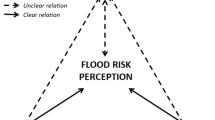Abstract
To guarantee a safe flood defence in a changing environment, the adaptation to climate change needs to be considered in the design of river dikes. However, the large uncertainty in the projections of future climate leads to varied estimations of future flood probability. How to cope with the uncertainties in future flood probability under climate change is an inevitable question in the adaptation. In this paper, the uncertainty introduced by climate projections was integrated into the ‘expected predictive flood probability’, and the risk-aversion attitude was introduced in the adaptation of river dikes. The uncertainty of climate change impact on flood probability was represented by the uncertainty in the parameters of the probabilistic model. This parameter uncertainty was estimated based on the outputs from the GCMs participated in IPCC AR4. The parameter uncertainty estimated from different GCMs under selected scenarios was integrated into the expected predictive probability of flooding, which was used in the risk-averse economic optimization. Different optimal results were obtained based on varied values of the risk-aversion index. A case of dike ring area in China was studied as an example using the proposed approach. The results show that the uncertainty of climate change increases the optimal dike height and decreases the optimal safety level. The proposed approach enables decision makers to cope with the climate change and the associated uncertainty by adjusting the risk-aversion level.









Similar content being viewed by others
References
Aven T, Flage R (2009) Use of decision criteria based on expected values to support decision-making in a production assurance and safety setting. Reliab Eng & Syst Saf 94(9):1491–1498
Bastola S, Murphy C, Sweeney J (2011) The sensitivity of fluvial flood risk in Irish catchments to the range of IPCC AR4 climate change scenarios. Sci Total Environ 409(24):5403–5415
Das T, Dettinger M, Cayan D, Hidalgo H (2011) Potential increase in floods in California’s Sierra Nevada under future climate projections. Clim Chang 109(1):71–94
Golian S, Yazdi J, Martina MLV, Sheshangosht S (2014) “A deterministic framework for selecting a flood forecasting and warning system at watershed scale.” Journal of Flood Risk Management: n/a-n/a
Jonkman SN, van Gelder PHAJM, Vrijling JK (2003) An overview of quantitative risk measures for loss of life and economic damage. J Hazard Mater 99(1):1–30
Kay A, Davies H, Bell V, Jones R (2009) Comparison of uncertainty sources for climate change impacts: flood frequency in England. Clim Chang 92(1–2):41–63
Kuijper B, Kallen M (2010) “The impact of risk aversion on optimal economic decisions”
Kuijper B, Kallen M (2012) Uncertainty in optimal decisions for dike maintenance. Struct Infrastruct Eng 8(4):317–327
Kundzewicz Z, Hirabayashi Y, Kanae S (2010) River floods in the changing climate—observations and projections. Water Resour Manag 24(11):2633–2646
Leander R, Buishand TA, van den Hurk BJ, de Wit MJ (2008) Estimated changes in flood quantiles of the river Meuse from resampling of regional climate model output. J Hydrol 351(3):331–343
Middelkoop H, Daamen K, Gellens D, Grabs W, Kwadijk JCJ, Lang H, Parmet BWAH, Schädler B, Schulla J, Wilke K (2001) Impact of climate change on hydrological regimes and water resources management in the Rhine basin. Clim Chang 49(1–2):105–128
Milly PCD, Wetherald RT, Dunne KA, Delworth TL (2002) Increasing risk of great floods in a changing climate. Nature 415(6871):514–517
Moss RH, Edmonds JA, Hibbard KA, Manning MR, Rose SK, van Vuuren DP, Carter TR, Emori S, Kainuma M, Kram T, Meehl GA, Mitchell JF, Nakicenovic N, Riahi K, Smith SJ, Stouffer RJ, Thomson AM, Weyant JP, Wilbanks TJ (2010) The next generation of scenarios for climate change research and assessment. Nature 463(7282):747–756
Nakicenovic N, Alcamo J, Davis G, de Vries B, Fenhann J, Gaffin S, Gregory K, Grubler A, Jung TY, Kram T (2000) Special report on emissions scenarios: a special report of working group III of the intergovernmental panel on climate change. Pacific Northwest National Laboratory, Environmental Molecular Sciences Laboratory, Richland, WA (US)
Prudhomme C, Reynard N, Crooks S (2002) Downscaling of global climate models for flood frequency analysis: where are we now? Hydrol Process 16(6):1137–1150
RÄIsÄNen J (2007) How reliable are climate models. Tellus A 59(1):2–29
Slijkhuis KAH, Van Gelder PHAJM, Vrijling J (1997) Optimal dike height under statistical-construction-and damage uncertainty. Struct Saf and Reliab 7:1137–1140
Van Dantzig D (1956) “Economic decision problems for flood prevention.” Econometrica: Journal of the Econometric Society: 276–287
Van Gelder PHAJM (1996) How to deal with wave statistical and model uncertainties in the design of vertical breakwaters. Probabilistic Design Tools for Vertical Breakwaters; Proceedings Task 4 Meeting, Hannover, Germany
Van Gelder, PHAJM, Vrijling JK (1998) Sensitivity analysis of reliability-based optimization in sea dike designs. Sensitivity Analysis of Model Output: 313–315
Vrijling JK, Van Hengel W, Houben R (1995) A framework for risk evaluation. J Hazard Mater 43(3):245–261
Xu Y, Chen P (1999) Economic assessment of flood defense system Bengbu City (In Chinese). J of Econ of Water Resour 5:30–33
Xu C-Y, Widén E, Halldin S (2005) Modelling hydrological consequences of climate change—progress and challenges. Adv Atmos Sci 22(6):789–797
Yang C, Yu Z, Hao Z, Zhang J, Zhu J (2012) Impact of climate change on flood and drought events in Huaihe River Basin, China. Hydrol Res 43(1–2):14–22
Zhao R-J (1992) The Xinanjiang model applied in China. J Hydrol 135(1–4):371–381
Acknowledgements
The work of the first author was supported by a fellowship program of the China Scholarship Council (CSC), China. The contribution of the fifth author to this work was partly supported by the AXA Research fund and the Deltares Harbour, Coastal and Offshore Engineering Research Programme 'Bouwen aan de Kust'. The authors are grateful to three anonymous reviewers for their valuable comments which greatly improved the manuscript.
Author information
Authors and Affiliations
Corresponding author
Rights and permissions
About this article
Cite this article
Wang, L., van Gelder, P.H.A.J.M., Vrijling, J.K. et al. Risk-Averse Economic Optimization in the Adaptation of River Dikes to Climate Change. Water Resour Manage 29, 359–377 (2015). https://doi.org/10.1007/s11269-014-0814-9
Received:
Accepted:
Published:
Issue Date:
DOI: https://doi.org/10.1007/s11269-014-0814-9




